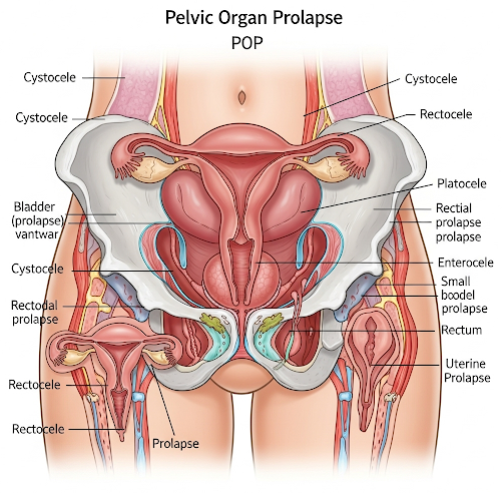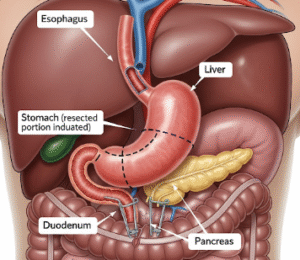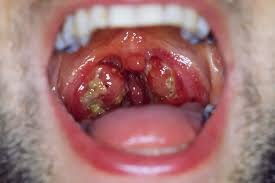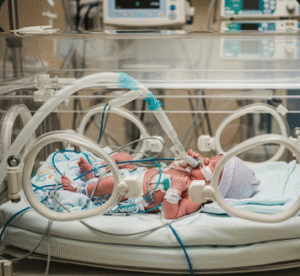Overview
Pelvic Organ Prolapse (POP) is a condition where the muscles and tissues supporting the pelvic organs weaken, allowing one or more organs—such as the bladder, uterus, rectum, or small bowel—to drop or press into the vaginal canal. It is a common condition, especially among women who have experienced childbirth, menopause, or pelvic surgery. Though not life-threatening, POP can cause significant discomfort, urinary or bowel issues, and impact quality of life.
What is Pelvic Organ Prolapse?
Pelvic Organ Prolapse occurs when the pelvic floor muscles and ligaments become stretched, weakened, or damaged. These muscles normally hold the pelvic organs in place. When they fail, the organs can bulge or descend into the vagina.
Types of pelvic organ prolapse include:
- Cystocele – Bladder prolapse into the front wall of the vagina
- Rectocele – Rectum pushing into the back wall of the vagina
- Uterine prolapse – Uterus descends into the vaginal canal
- Enterocele – Small intestine presses into the top of the vagina
- Vaginal vault prolapse – Top of the vagina falls, often after hysterectomy
Symptoms
Symptoms depend on the type and severity of prolapse, and they may worsen throughout the day or with physical activity.
Common symptoms include:
- A feeling of pressure or fullness in the pelvis
- A bulge or lump in the vagina
- Urinary incontinence or difficulty emptying the bladder
- Bowel movement issues or constipation
- Pain or discomfort during sex
- Lower back pain
- Feeling like something is “falling out” of the vagina
- Spotting or bleeding (in severe cases)
Causes
Pelvic organ prolapse is usually caused by damage or weakening of the pelvic floor due to:
- Vaginal childbirth, especially with large babies or prolonged labor
- Aging and menopause (decline in estrogen)
- Chronic coughing (e.g., from smoking or lung disease)
- Heavy lifting
- Obesity
- Frequent straining during bowel movements
- Hysterectomy or other pelvic surgeries
- Genetic predisposition (weaker connective tissue)
Risk Factors
Women are at higher risk of POP due to anatomy and life events. Key risk factors include:
- Multiple vaginal deliveries
- Advanced age
- Menopause and low estrogen
- Obesity
- Chronic constipation or straining
- Family history of POP
- Connective tissue disorders (e.g., Ehlers-Danlos syndrome)
- History of pelvic surgery
Complications
While not usually dangerous, untreated or severe prolapse can lead to:
- Bladder and bowel dysfunction
- Recurrent urinary tract infections
- Incontinence
- Sexual dysfunction
- Worsening pelvic pain or discomfort
- Prolapsed tissue ulceration or bleeding
- Mental health effects like embarrassment or anxiety
Prevention
Although not all cases are preventable, the following steps can help reduce risk:
- Perform Kegel exercises to strengthen pelvic floor muscles
- Maintain a healthy weight
- Avoid heavy lifting
- Treat chronic cough or constipation early
- Use proper lifting techniques
- Seek early care if symptoms begin
- Consider estrogen therapy after menopause (under doctor’s advice)
Treatment Options in Korea
South Korea offers comprehensive and high-standard treatment for Pelvic Organ Prolapse, with many hospitals providing multidisciplinary pelvic health clinics.
1. Diagnosis
- Pelvic examination by a gynecologist or urologist
- Ultrasound or MRI of the pelvic organs
- Urodynamic studies to assess bladder function
- Defecography for bowel-related prolapse
2. Conservative Treatments
- Pelvic Floor Physical Therapy: Core strengthening, biofeedback, and muscle coordination training
- Pessary Devices: Silicone inserts that support the vaginal wall and pelvic organs, ideal for non-surgical patients
- Estrogen therapy: For postmenopausal women with vaginal tissue thinning
- Lifestyle adjustments: Weight loss, dietary changes, and bowel management
3. Surgical Treatments
- Reconstructive pelvic surgery: To restore the position of prolapsed organs
- Sacrocolpopexy, hysteropexy, or colporrhaphy
- Minimally invasive laparoscopic or robotic-assisted surgeries
- Vaginal mesh repair (cautiously used under strict regulation in Korea)
- Hysterectomy: If uterine prolapse is present and fertility is not a concern
4. Postoperative Care
- Physiotherapy and rehab to strengthen pelvic muscles post-surgery
- Ongoing monitoring to prevent recurrence
- Mental health support if needed
Top Korean medical centers like Severance Hospital, Asan Medical Center, and Samsung Medical Center provide world-class treatment with access to female pelvic health specialists, robotic surgery, and bilingual patient care services for international patients.













